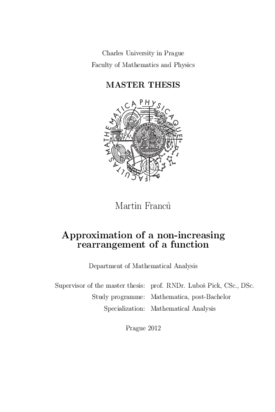Approximation of a non-increasing rearrangement of a function
Aproximace nerostoucího přerovnání funkce
diplomová práce (OBHÁJENO)

Zobrazit/
Trvalý odkaz
http://hdl.handle.net/20.500.11956/40858Identifikátory
SIS: 122517
Katalog UK: 990015039690106986
Kolekce
- Kvalifikační práce [11978]
Autor
Vedoucí práce
Oponent práce
Felcman, Jiří
Fakulta / součást
Matematicko-fyzikální fakulta
Obor
Matematická analýza
Katedra / ústav / klinika
Katedra matematické analýzy
Datum obhajoby
18. 9. 2012
Nakladatel
Univerzita Karlova, Matematicko-fyzikální fakultaJazyk
Angličtina
Známka
Výborně
Klíčová slova (česky)
aproximace, nerostoucí přerovnání, simplex, metoda konečných prvkůKlíčová slova (anglicky)
approximation, non-increasing rearrangement, simplex, finite-element methodNerostoucí přerovnání měřitelné realné funkce definované na měřitelném prostoru má obrovský význam v takových disciplínách jako je teorie prostorů funckcí nebo teorie interpolací (mezi prostory funkcí) a jejich aplikace v parcialních diferencialních rovnicích. Ačkoliv má merostoucí přerovnání dobré a široce uplatnitelné vlastnosti jako zobrazení, je bohužel témeř nemožné vypočítat nerostoucí přerovnání konkrétní funkce přesně. Z tohoto důvodu jsou numerické algoritmy pro aproximaci žádoucí. V této práci se budeme zabývat takovou metodou postavenou na interpolaci pomocí lineárních splinů. V první polovině této práce bude tato metoda popsána, zatímco odhady chyb budou předmětem druhé části.
The non-increasing rearrangement of a measurable real function defined on an appropriate measure space is of the enormous significance in disciplines such as theory of function spaces or interpolation theory and their applications in PDEs. Unfortunately, while it has good and widely applicable mapping properties, it is virtually impossible to calculate the non-increasing rearrangement of a concrete given function precisely. Numerical algorithms for approximation are desirable for this reason. Such method of approximation, based on interpolation by a linear spline, is presented in this thesis. In the first half of this thesis, the developed method is described, while the error estimates of the method are subject to the second part.
